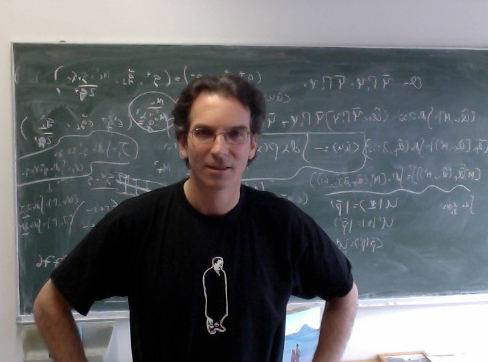By Matt Sinclair ’90
What if the world we live in is simulated reality, and just what does that mean?

Silas Beane ’88
That is one of various questions on the mind of Silas R. Beane ’88, who has spent the past year conducting pure research as the Mercator Professor of Physics at the University of Bonn, Germany. His work focuses on lattice quantum chromodynamics (QCD), which uses high-performance computing to calculate the properties of what is essentially a very tiny simulated universe—a cube with sides of several femtometers—to determine properties of atomic nuclei. A femtometer equals 10-15 meters. The results have called attention to some intriguing “glitches.”
Recently elected a fellow of the prestigious American Physical Society, Beane explains that in the calculations of particles and nuclei, the glitches are expected artifacts that have to be removed from the calculations.
“Of course if we’re in a simulation of a similar type, then observable glitches do become interesting, because they would allow us to see that we’re being simulated,” he says.
“Last year, we applied some of the technology that we use to describe the glitches in our calculations of nuclei to a hypothetical scenario where our universe is assumed to be a vastly scaled up simulation of the sort that we use to study the nuclei,” says Beane, who earned his Ph.D. in physics at University of Texas–Austin. “The most interesting finding is that the spectrum of very high energy cosmic rays would be modified if our universe had a finite grid size.”
Beane’s work is mentioned in “Is the Universe a Simulation?” in The New York Times (Feb. 14, 2014) in the Gray Matter column by Edward Frenkel. The research paper, “Constraints on the Universe as a Numerical Simulation,” which Beane coauthored with Zohreh Davoudi and Martin J. Savage, is discussed.
A physics graduate, Beane says Bradley Antanaitis, associate professor of physics, introduced him to quantum theory, which now is the basic tool of his daily research.
“Brad’s influence on my way of thinking about physics was huge and really helped me when I arrived in graduate school,” he says. “I still have my notes from Brad’s extremely clear lectures.”
The members of the Physics Department in the 1980s initially sparked Beane’s interest in the field.
“After having worked at many universities, I’m still amazed by the dedication to teaching exhibited by these professors,” he says.
“They were always available and always extremely kind and encouraging. There was no hierarchy with any of these guys; it was more like having very good friends who possessed tremendous knowledge that they were always willing to share. I’d certainly be in a different place today without their influence.”
This legacy informs his primary calling. Beane says he considers his simulated reality work tangential to his research in lattice QCD and his teaching of undergraduate and graduate students. After completing the fellowship in Bonn this August, Beane will assume a new position as associate professor of physics at the University of Washington.
A theoretical physicist, Beane’s primary research area is lattice QCD. He is a member of the collaborative group Nuclear Physics from Lattice QCD, which has the purpose of calculating the properties and interactions of nuclei directly from the underlying theory.
Assisting students through another avenue, he and his father, S. Robert “Bob” Beane Jr. ’58, an emeritus trustee, established the S. Robert ’58 & Silas R. Beane ’88 Scholarship awarded to students from northern New Jersey. In addition, the Beane Technology Studio in Skillman Library is named in honor of their generous support of the 2004 expansion and renovation.
